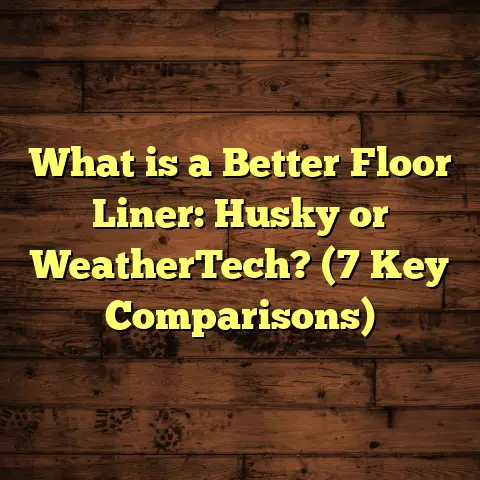What is Terrazzo Flooring Made Of? (5 Key Materials Explained)
You ever walk into a room and find yourself staring down at the floor? I’ve been on countless jobs where the flooring was the centerpiece—the piece that tied everything together visually and functionally. Terrazzo flooring often steals the show. But if you’re like many people, you might wonder: What exactly is terrazzo flooring made of? Why does it have that unique look? And how does it hold up over time? I’ll share everything I’ve learned—over a decade of hands-on work—about the five key materials that make terrazzo floors what they are.
What Is Terrazzo Flooring Made Of?
Terrazzo is a composite flooring material. That means it’s made from a blend of different ingredients combined to create something durable, beautiful, and customizable. The core idea is this: small pieces of stone or glass are mixed into a binder—usually cement or resin—and after everything hardens, the surface is ground and polished smooth. The result is a speckled, mosaic-like floor that can be customized in color, texture, and pattern.
I remember my first encounter with terrazzo. It was back when I worked as an apprentice on a restoration project in an old theater. The original terrazzo floor had worn down but still dazzled beneath layers of dirt. After stripping and polishing, it came back to life with brilliant chips of marble shining through a gray cement base. That sparked my interest in this flooring type.
Over the years, I’ve worked on everything from small residential kitchens to huge commercial lobbies with terrazzo floors. Each project taught me more about which materials to use and how they impact durability, aesthetics, and maintenance.
Let’s go over the five main materials that make up terrazzo flooring:
1. Aggregates (Chips): The Stars of Terrazzo
Aggregates are the pieces you see embedded in the floor’s surface. They come in different materials and sizes, giving terrazzo its distinctive look.
Types of Aggregates
- Marble Chips: These are the traditional choice and by far the most common. Marble offers a wide range of colors—from whites and creams to deep greens and blacks. Marble chips make up roughly 70-80% of aggregates used in terrazzo worldwide. Their natural veining adds depth and character.
- Glass Chips: Using glass chips adds sparkle and vibrant colors. Some clients love recycled glass because it’s eco-friendly and can be sourced in many hues. The glass catches light differently than stone, giving terrazzo a modern pop.
- Quartz & Granite: These stones are harder and more durable than marble. For high-traffic commercial spaces like airports or hospitals, quartz and granite chips are great because they resist wear better.
- Other Aggregates: Occasionally, you’ll see chips made from shell, mother-of-pearl, or even metals like brass for decorative purposes.
My Experience with Aggregates
I once worked on a boutique hotel renovation where the owner wanted something unique but durable. We mixed traditional white marble chips with crushed recycled glass from local sources. The effect was subtle but eye-catching—a floor that caught sunlight during the day and artificial lighting at night.
One tricky part is sizing the chips correctly. Larger chips are bolder but can make polishing more difficult; smaller chips give a smoother look but can feel less textured underfoot.
Data Point: Aggregate Usage
Studies show that marble chips typically account for about 75% of aggregate volume in terrazzo floors globally, followed by glass at around 15%, with quartz and granite making up smaller percentages. This reflects balance between aesthetics, cost, and durability.
2. Binder (Matrix): The Glue Holding It Together
The binder is what holds all those aggregates in place. Without a strong binder, your terrazzo floor won’t last long.
Types of Binders
- Cementitious Binder: This is traditional terrazzo made with Portland cement as the binder. Cement terrazzo is breathable and has a natural matte finish before polishing. It takes longer to cure—usually around 28 days—but it’s tough and time-tested.
- Resin Binder: Epoxy or polyester resins serve as binders for modern terrazzo floors. Resin terrazzo cures faster—sometimes within 24-48 hours—and allows for thinner installations. Plus, it offers more color options since pigments can be added easily.
- Polymer-modified Cement: A hybrid approach mixing cement and polymer resin to improve flexibility and reduce curing time.
Which Binder Do I Prefer?
For residential projects where budget and tradition matter, I often recommend cementitious terrazzo—it’s classic and durable. For commercial or high-design projects where quick turnaround and color vibrancy are priorities, epoxy resin is usually better.
For example, in a recent office lobby renovation, we used epoxy resin with custom pigments to match corporate branding colors perfectly. The quick curing time helped meet tight deadlines without sacrificing quality.
Technical Insight: Binder Performance
Epoxy resins typically have compressive strengths exceeding 8,000 psi (pounds per square inch), while Portland cement-based terrazzo ranges between 3,000-5,000 psi depending on mix design. That means epoxy can handle heavier loads and flex better under stress.
3. Pigments: Adding Color and Character
Pigments tint the binder to achieve different color effects.
How Pigments Work
In cementitious terrazzo, iron oxide pigments are most common—offering earthy reds, yellows, browns—and sometimes synthetic pigments for brighter shades.
In resin-based terrazzo, pigments come in liquid or powder form that mixes directly into epoxy or polyester resins. This allows for vivid colors like bright blues or greens that wouldn’t be possible with cement alone.
Why Pigments Matter
Some clients want monochromatic floors where the color of the binder matches or contrasts with aggregates for a subtle or bold effect.
I recall a kitchen renovation where the client wanted a pale green base with white marble chips—something soft and calming. Using pigments allowed us to customize that exact shade without relying on natural cement colors.
Pigments also help with branding in commercial spaces—think logos embedded in floors or school colors showcased throughout corridors.
4. Reinforcement: Strength You Can’t See
Reinforcement materials like wire mesh or synthetic fibers are sometimes added beneath or within terrazzo slabs to prevent cracking.
When Reinforcement Is Needed
Terrazzo slabs can be large and subject to movement due to temperature changes or structural settling. Reinforcement reduces stress and extends floor life.
In large-scale installations—like airports or hospitals—I always recommend reinforcement because these floors see heavy foot traffic and occasional equipment loads.
My Story with Reinforcement
On a gymnasium floor project for a local school, we installed wire mesh beneath the cementitious terrazzo slab. The school district had concerns about cracking due to temperature swings and heavy sports equipment moving around.
Years later, that floor still looks great with no visible cracks—a direct result of careful reinforcement placement.
5. Sealers and Finishes: Protecting Your Investment
After grinding and polishing terrazzo floors smooth, sealers protect them from stains, moisture, and wear.
Types of Sealers
- Penetrating Sealers soak into the porous surface without changing texture or slip resistance.
- Surface Sealers form a film on top but can become slippery or wear off quickly.
I always recommend penetrating sealers paired with routine neutral cleaner maintenance for longevity.
Maintenance Tips I’ve Learned
Terrazzo floors can last over 40 years if maintained properly. Avoid harsh cleaners that etch surfaces or degrade sealers. Use mats at entrances to reduce dirt tracked inside.
Comparing Different Terrazzo Flooring Options I’ve Worked With
Table time! Here’s how different combinations stack up based on my experience:
| Type | Binder | Aggregate | Pros | Cons | Typical Use Cases |
|---|---|---|---|---|---|
| Traditional | Cementitious | Marble | Breathable, classic look | Long curing time | Residential, historic restorations |
| Resin-based | Epoxy resin | Glass & Marble | Vibrant colors, quick curing | UV sensitivity | Commercial spaces, modern designs |
| Polymer-modified | Cement + resin | Mixed aggregates | Improved strength & flexibility | Higher cost | Large commercial installations |
What Makes Terrazzo So Durable?
Terrazzo’s durability comes from its composite nature:
- Aggregates like marble or granite provide hardness.
- Binders hold pieces tightly while absorbing stress.
- Reinforcements prevent cracks from spreading.
- Sealers protect against stains and moisture penetration.
From personal observation across dozens of projects:
- Terrazzo floors resist scratches better than hardwood or laminate.
- They handle heavy foot traffic without visible wear for decades.
- They’re fire resistant compared to vinyl or carpet options.
In one hospital project I oversaw, terrazzo floors maintained their integrity after years of cleaning chemicals and constant foot traffic—a testament to their toughness.
Cost Insights: What Does Terrazzo Flooring Cost?
Here’s what I typically see for pricing:
- Cementitious terrazzo: $15-$25 per square foot installed.
- Epoxy resin terrazzo: $20-$30 per square foot installed.
- Polymer-modified terrazzo: $25-$35 per square foot installed.
Factors influencing cost:
- Aggregate type (marble vs recycled glass)
- Binder choice
- Floor complexity (patterns or logos add labor)
- Location-based labor rates
Despite being pricier upfront than vinyl or laminate, terrazzo’s lifespan—often 40+ years—makes it cost-effective long term.
Detailed Case Study: Office Lobby Terrazzo Installation
Here’s a closer look at my recent work on an office lobby:
Project Overview
Client: Mid-sized tech company
Area: 1,200 sq ft lobby
Requirements: Durable floor with corporate branding colors, quick installation
Materials Chosen
- Binder: Epoxy resin (fast curing)
- Aggregates: White marble chips + recycled blue glass chips
- Pigments: Custom corporate blue pigment in binder
- Reinforcement: None (floor slab was structurally sound)
- Finish: Penetrating sealer
Process & Timeline
- Surface prep & concrete repair (2 days)
- Epoxy binder + aggregates installation (3 days)
- Grinding & polishing (2 days)
- Sealing & curing (1 day)
Total time: Approximately 8 working days
Outcome & Feedback
The client was thrilled with the final product:
- The floor matched their brand colors perfectly.
- It handled foot traffic from employees & visitors with no damage.
- Maintenance was simple with neutral cleaners recommended.
This project showed me how resin terrazzo can blend aesthetics with practicality beautifully.
Frequently Asked Questions I Hear About Terrazzo Materials
Q: Can you use terrazzo outdoors?
A: Yes, but cementitious terrazzo is preferred since epoxy resin can yellow under UV exposure unless special UV-resistant resins are used.
Q: How thick is a typical terrazzo floor?
A: Usually about 1/2″ to 3/4″ thick depending on binder type and aggregate size.
Q: Is terrazzo slippery?
A: Polished terrazzo can be slippery when wet; using matte finishes or anti-slip sealers helps reduce risk.
Q: How do I clean terrazzo?
A: Use pH-neutral cleaners designed for stone surfaces; avoid acids or harsh abrasives.
Wrapping Up My Take on Terrazzo Materials
If you’re thinking about terrazzo flooring now, know this—it’s so much more than just pretty chips in cement. Each ingredient matters:
- Aggregates bring beauty & texture.
- Binders provide strength & flexibility.
- Pigments let you play with color.
- Reinforcement ensures long-term durability.
- Sealers protect your investment.
I’ve seen floors made with different combos succeed in different settings—from cozy homes to busy airports—and each time it comes down to choosing materials that fit your needs best.
Have questions about your next flooring project? I’m happy to share what I know about getting the right terrazzo mix for your space!
If you want me to add anything else—like detailed maintenance tips or installation challenges—I’m here to help!





